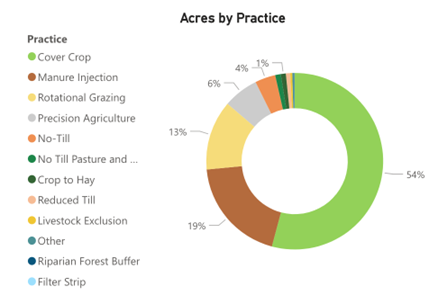By Maria Burnett, Vermont Agency of Agriculture, Food & Markets
Every year in January the Vermont Agency of Agriculture, Food & Markets delivers a report to the legislature highlighting the efforts to improve water quality in the past state fiscal year. Here are some highlights from State Fiscal Year (SFY) 2023, which covers July 1st, 2022, to June 30, 2023.
By the numbers:
- $15.5 million was invested in water quality projects through the Agency’s technical and financial assistance programs, leveraging an additional $1.9 million in federal match and almost $1 million in local farm match in FY 2023. This is an increase from $10.4 million in state investments during FY 2022.
- 50,000 acres of conservation practices were implemented, more than 3,700 acres of farm production area facilities were inspected, and as a result approximately 24,000 kg of reduced phosphorus loading is estimated in the Lake Champlain and Lake Memphremagog Basins.
- More than 800 on-site technical assistance and regulatory visits were completed by Agency staff. These visits are essential for ensuring compliance with the Regulatory Agricultural Practices and supporting farmers to implement effective conservation practices that result in improved water quality.
- Almost $1 million was contributed by farmers as a match towards state funded farm water quality improvements in FY 2023.
- According to the state’s estimated total phosphorus load reduction tracking and accounting for SFY2023 -
- 20% of Lake Champlain Basin Total Maximum Daily Load (TMDL) Targets have been met, and
- 14% of Lake Memphremagog TMDL Targets have been met.
Program Highlights:
Last fall, Agency staff member Ellen Friedrich worked with 9 undergraduate students from the University of Vermont on a semester-long project focused on agricultural filter strips and the Grassed Waterway and Filter Strip (GWFS) program. The Agency hopes to revamp this program to make the program more accessible to farms, and to encourage more farm participation to improve buffers and to seed down critical source areas to perennial vegetation (or areas that may contribute to high rates of phosphorus runoff).
When speaking about the Capital Equipment Assistance Program (CEAP), Justin Rich, owner of Burnt Rock farm in Huntington, VT, states “this is one of the best types of grant programs. The program asks existing operations what they need… the solutions are out there.”
When speaking about the Farm Agronomic Practices (FAP) Program, David Rosso from Fairview Farm in East Dover, VT, states “it is really evident that all the state employees I have worked with want you to succeed. They care about agriculture and the type of farming you do. I really think more farms should utilize these programs.” Between SFY 2016 and 2023, agronomic practice implementation has accounted for most of the estimated phosphorus reductions in Vermont.
The Agency launched a new program this year, the Vermont Farmer Ecosystem Stewardship (VFESP) which offers supplemental incentive payments to farmers who enroll in the USDA-NRCS Conservation Stewardship Program (CSP). More than 80 farms across Vermont have taken advantage of this one-time incentive opportunity.
When speaking about the Vermont Pay for Performance Program (VPFP), Guy Choiniere, owner of a grass-fed dairy farm in Highgate, VT states, “the (V)PFP program has been a pleasant surprise! Even though we have an all-grass farm… this program provides incentives and rewards for using best management practices such as nutrient management planning and rotational grazing.”
In SFY2023, more than 50,000 acres of agronomic practices to improve water quality were supported through Agency programs such as FAP and CEAP. Below is a chart which shows the top practice supported was Cover Crop, followed by Manure Injection and Rotational Grazing.

Figure 1: Percentage of conservation practices supported through Agency programs in SFY 2023.
Looking Ahead
2023 was a challenging year for Vermont farmers with record setting precipitation seen across the state. .In the face of natural disasters and other impacts to Vermont’s growing climate, the Agency wants to thank Vermont farmers who continue to demonstrate their commitment to the adoption of conservation practices and improving water quality. The Agency will strive to continue serving farms and partnering with the agricultural community to meet technical and financial assistance needs while improving processing and efficiency. We look forward to continuing to share with the legislature and the public how much work Vermont farmers are putting towards improving water quality in Vermont.
For more information on the results of efforts led by the Agency of Agriculture Division of Water Quality, visit agriculture.vermont.gov/water-quality/additional-resources-and-reports. If you have any questions or would like assistance implementing a clean water project on your farm, reach out to the Water Quality Division at 802-828-2431 or AGR.WaterQuality@Vermont.gov!

